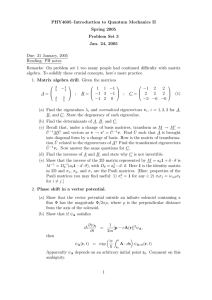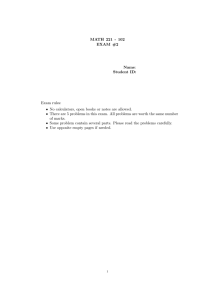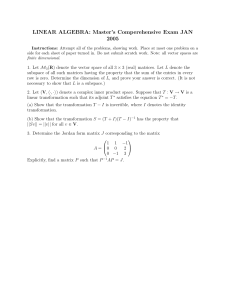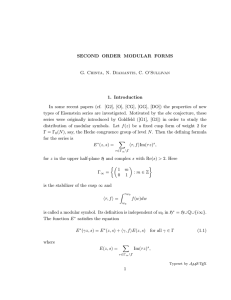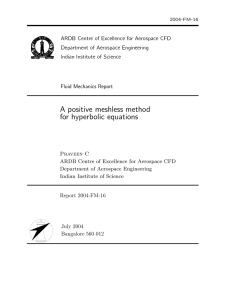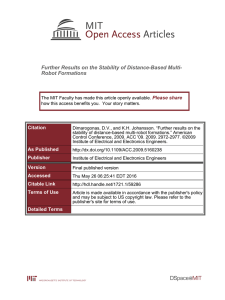Background on Linear Algebra - Lecture 2 1 Introduction ∗
advertisement
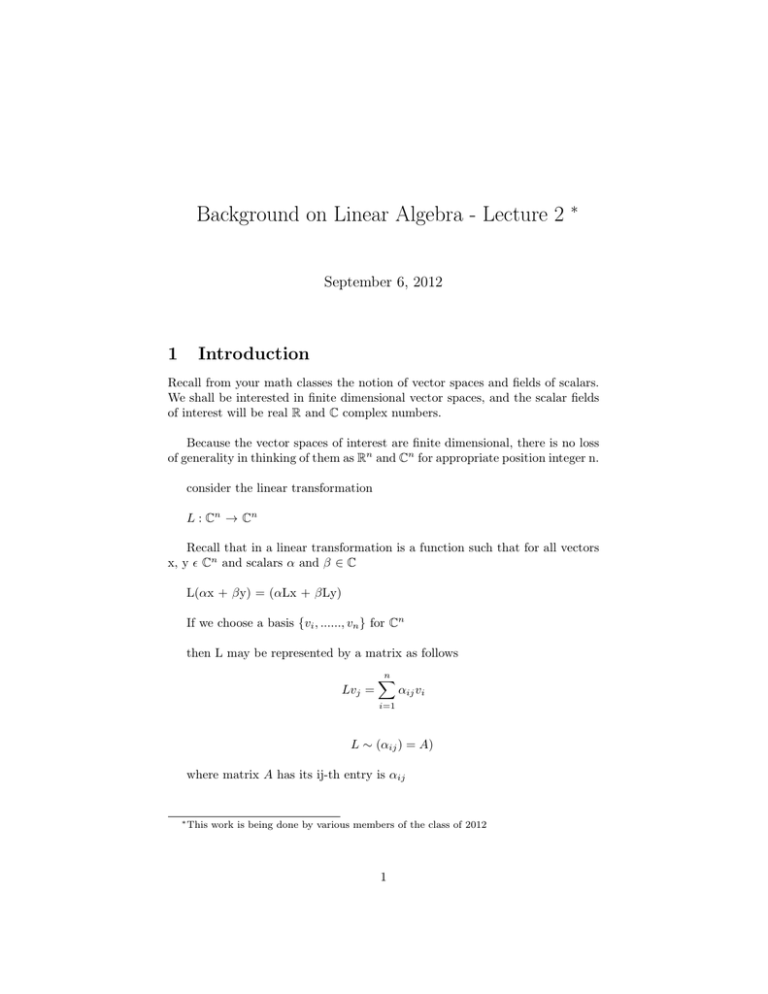
Background on Linear Algebra - Lecture 2
∗
September 6, 2012
1
Introduction
Recall from your math classes the notion of vector spaces and fields of scalars.
We shall be interested in finite dimensional vector spaces, and the scalar fields
of interest will be real R and C complex numbers.
Because the vector spaces of interest are finite dimensional, there is no loss
of generality in thinking of them as Rn and Cn for appropriate position integer n.
consider the linear transformation
L : C n → Cn
Recall that in a linear transformation is a function such that for all vectors
x, y Cn and scalars α and β ∈ C
L(αx + βy) = (αLx + βLy)
If we choose a basis {vi , ......, vn } for Cn
then L may be represented by a matrix as follows
Lvj =
n
X
αij vi
i=1
L ∼ (αij ) = A)
where matrix A has its ij-th entry is αij
∗ This
work is being done by various members of the class of 2012
1
Dynamic Systems: State-space control
2
What if we choose another basis
{w1 , ......, wn } and write
L ∼ (bij ) = B ?
While it might look like a given linear transformation can be represented by
any of a given number of arbitrary different matrices, this is not a case
Note: any two basis are related by a “change of basis” matrix
wj =
n
X
pij vi
i=1
where the pij ’s are uniquely determined scalars. Write P ∼ (pij )
Note that P is an invertable matrix. This follows easily because the basis
(vi . . . , vn ) may be expressed in terms of the basis (wi , . . . , wn )
vj =
n
X
qij wi
i=1
(qiy ) ∼ Q
clearly Q = P −1 (Proof for this is left to the students.)
On the one hand
Lwj =
n
X
p`j Lv`
`=1
=
n X
n
X
(
αk` vk )
`=1 k=1
=
n
X
n
X
(
αk` p`j )vk .
k=1 `=1
Dynamic Systems: State-space control
3
On the other hand
Lwj =
n
X
βij wi
i=1
=
n
X
βij (
i=1
=
n
X
pki vk )
k=1
n X
n
X
(
pki βij )vk
k=1 i=1
n X
n
n X
n
X
X
(
pki βij )vk =
(
αk` p`j )vk .
k=1 i=1
k=1 `=1
0
Because the vk s form a basis , the coefficients of the vk 0 s in this equation
are equal term by term
n
X
i=1
pki βij =
n
X
αkl p`j
(k = 1, ...n), (j = 1, ..., n)
l=1
The left hand side is the kj entry in the matrix product AP. The right hand
side is the kj entry in the matrix product PB.
Theorem
Two square matrices A,B represent the same linear transformation if and
only if there is a non singular matrix P such that
B = P −1 AP
Proof
The calculation shows that there is a matrix P such that
P B = AP
Since P is invertible, the conclusion of the theorem follows.
Terminology
A → P −1 AP is called a similarity transformation.
Two matrices represent the same linear transformation if and only if they
are similar
Dynamic Systems: State-space control
4
Goal
When we look for matrix representations the goal will be to find expressions
that are as simple as possible—
for instance, we would like matrices to be sparse i.e. to have as many zero
elements as possible
Example
A=
3
1
1
3
Propose we let
P =
!
√1
2
− √12
√1
2
√1
2
√1
2
√1
2
− √12
then it is (almost) obvious that
P −1 =
we find that
B=
√1
2
√1
2
!
√1
2
!
√1
3 1
2
√1
1 3
− √12
2
2 0
=
.
0 4
− √12
√1
2
√1
2
!
Generally speaking square matrices with all non-zero elements (if any) confined to the principal diagno are as sparse as possible. under the operation of
similarity transformations.
Theorem
Any square n × n matrix with n distinct eigenvalues can be put into diagonal
form by a change of basis.
Proof
Let {e1 , ....., en } be any set of eigenvectors corresponding to the distinct
eigenvalues (λ1 , ......, λn )
Aej = λj ej (j = 1, ...., n)
Think of the eigenvectors as n-tuples of scalars, and if we think of these ntuples as column vectors, we can put them side by side to form an n × n matrix
Dynamic Systems: State-space control
5
M = (e1 · · · en )
AM = (λi ei :: λn en ) = M Λ
where
λ1
0
Λ= .
..
0
λ2
..
.
···
···
0
0
..
.
0
0
···
λn
This proves the theorem.
Exercise: M is non-singular hint: (e1 , ....., en ) form a basis
Example
1
0
1
a
this has an eigenvalue that are distinct if and only if a ¬1
might as well take the eigen vector corresponding to 1 to be
1
~e1 =
0
Note: eigenvectors remain eigenvectors if they are multiplied by a nonzero
scalar
we can take the eigen vector corresponding to a to be
1
~ea =
a−1
A diagnolizing transformation M such that
1 1
M −1
M
0 a
1 0
=
0 a
is
1
M=
0
1
.
a−1
Note that as a → 1, ~ea → e1 , and moreover, M becomes singular. What to
do?
Dynamic Systems: State-space control
6
Homework - go back and review what you know about elementary linear
algebra
next: where to go when eigenvalues are not distinct
2
Recommended reading
B.Noble & J.W. Daniel, Applied Linear Algebra, Prentice Hall, 1977
Gilbert Strang, Introduction to Linear Algebra 4th Edition, Wellesley Cambridge Press
Steven Roman, Advanced linear Algebra (Graduate texts in mathematics),
Springer 3rd Edition
F.R. Gantmacher, Matrix theory, Chealsea, NY 1960

